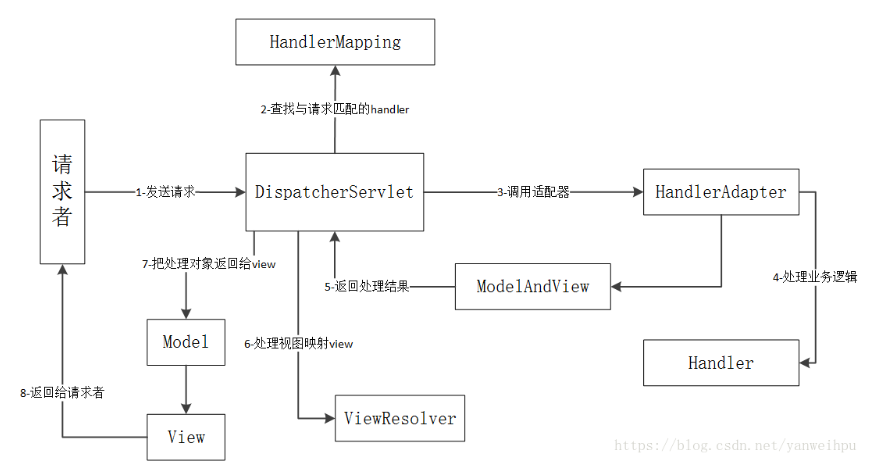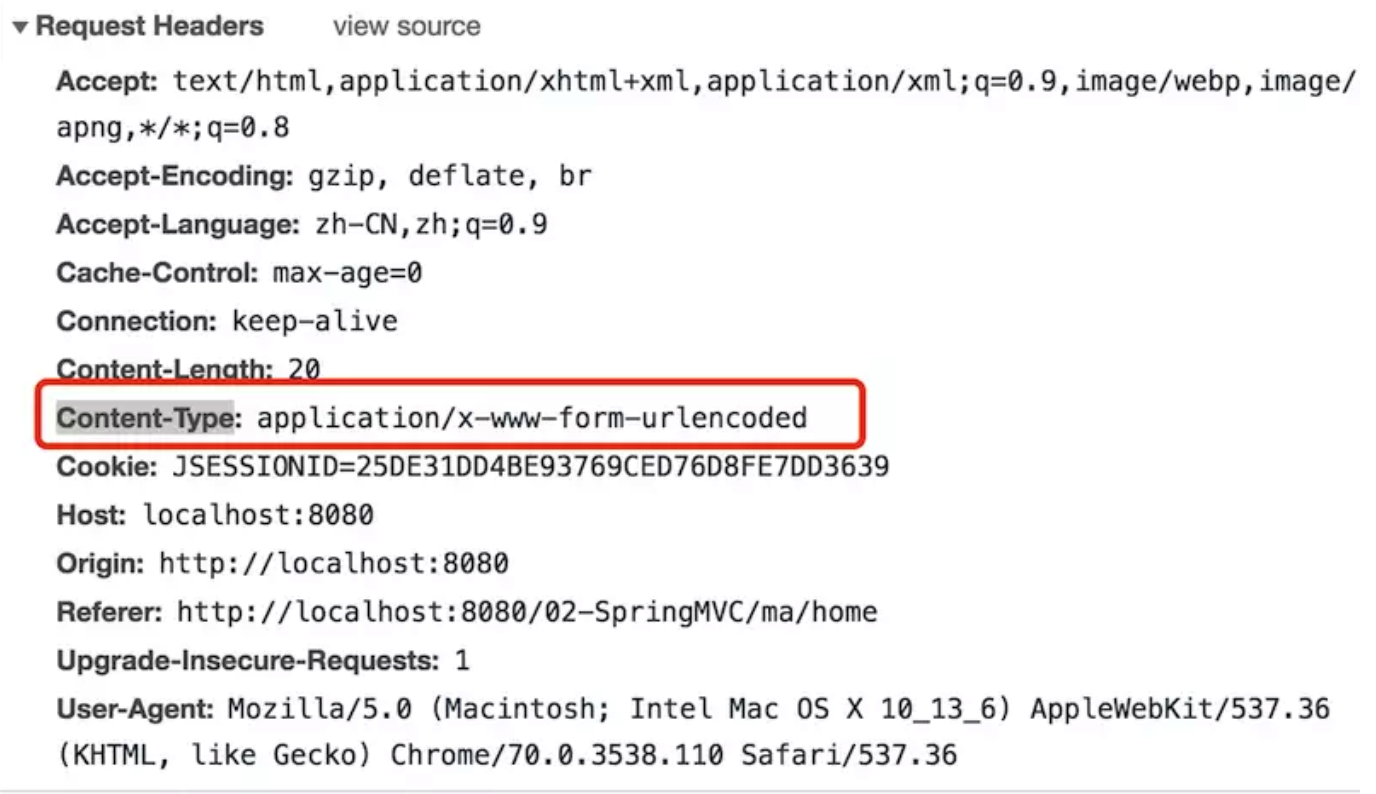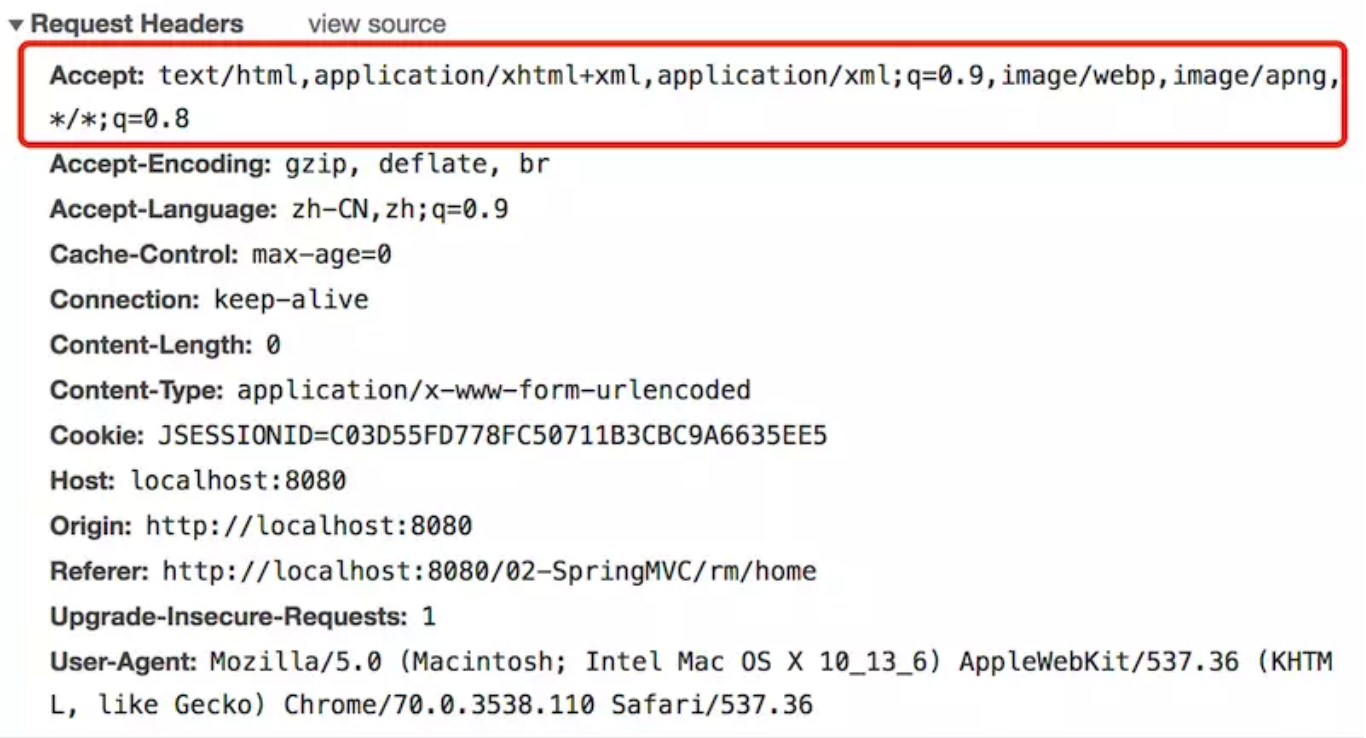SpringMVC框架是以请求为驱动,围绕Servlet设计,将请求发给控制器,然后通过模型对象,分派器来展示请求结果视图。其中核心类是DispatcherServlet,它是一个Servlet,顶层是实现的Servlet接口。
1 xml配置说明
1
2
3
4
5
6
7
8
9
10
11
12
13
14
| <servlet>
<servlet-name>springmvc</servlet-name>
<servlet-class>org.springframework.web.servlet.DispatcherServlet</servlet-class>
<!-- 如果不设置init-param标签,则必须在/WEB-INF/下创建xxx-servlet.xml文件,其中xxx是servlet-name中配置的名称。 -->
<init-param>
<param-name>contextConfigLocation</param-name>
<param-value>classpath:spring/springmvc-servlet.xml</param-value>
</init-param>
<load-on-startup>1</load-on-startup>
</servlet>
<servlet-mapping>
<servlet-name>springmvc</servlet-name>
<url-pattern>/</url-pattern>
</servlet-mapping>
|
容器初始化web.xml中配置的servlet,为其初始化自己的上下文信息servletContext,并加载其设置的配置信息到该上下文中。将WebApplicationContext(即spring ioc容器)设置为它的父容器。其中便有SpringMVC(假设配置了SpringMVC),这也是为什么spring ioc是springmvc ioc的父容器的原因
2 springMVC运行流程

流程说明:
(1)客户端(浏览器)发送请求,直接请求到DispatcherServlet。
(2)DispatcherServlet根据请求信息调用HandlerMapping,解析请求对应的Handler。
(3)解析到对应的Handler后,开始由HandlerAdapter适配器处理。
(4)HandlerAdapter会根据Handler来调用真正的处理器开处理请求,并处理相应的业务逻辑。
(5)处理器处理完业务后,会返回一个ModelAndView对象,Model是返回的数据对象,View是个逻辑上的View。
(6)ViewResolver会根据逻辑View查找实际的View。
(7)DispaterServlet把返回的Model传给View。
(8)通过View返回给请求者(浏览器)
3 SpringMVC初始化过程
init
HttpServlet中的init方法
1
2
3
4
5
6
7
8
9
10
11
12
13
14
15
16
17
18
19
20
21
22
| public final void init() throws ServletException {
PropertyValues pvs = new ServletConfigPropertyValues(getServletConfig(), this.requiredProperties);
BeanWrapper bw = PropertyAccessorFactory.forBeanPropertyAccess(this);
ResourceLoader resourceLoader = new ServletContextResourceLoader(getServletContext());
bw.registerCustomEditor(Resource.class, new ResourceEditor(resourceLoader, getEnvironment()));
initBeanWrapper(bw);
bw.setPropertyValues(pvs, true);
}
initServletBean();
...
}
|
DispatcherServlet的初始化过程主要是通过当前的servlet类型实例转换为BeanWrapper类型实例
initServletBean
该过程由子类完成。在FrameworkServlet中覆盖了HttpServletBean中的initServletBean方法,如下:
1
2
3
4
5
6
7
8
9
10
11
12
13
| protected final void initServletBean() throws ServletException {
...
try {
this.webApplicationContext = this.initWebApplicationContext();
this.initFrameworkServlet();
} catch (RuntimeException | ServletException var5) {
this.logger.error("Context initialization failed", var5);
throw var5;
}
...
}
|
进入关键方法initWebApplicationContext()
initWebApplicationContext
initWebApplicationContext方法的主要工作就是创建或者是刷新WebApplicationContext实例并对servlet功能所使用的变量进行初始化。
1
2
3
4
5
6
7
8
9
10
11
12
13
14
15
16
17
18
19
20
21
22
23
24
25
26
27
28
29
30
31
32
33
34
35
36
37
38
39
40
41
42
43
44
45
46
47
48
49
50
51
| protected WebApplicationContext initWebApplicationContext() {
WebApplicationContext rootContext =
WebApplicationContextUtils.getWebApplicationContext(getServletContext());
WebApplicationContext wac = null;
if (this.webApplicationContext != null) {
wac = this.webApplicationContext;
if (wac instanceof ConfigurableWebApplicationContext) {
ConfigurableWebApplicationContext cwac = (ConfigurableWebApplicationContext) wac;
if (!cwac.isActive()) {
if (cwac.getParent() == null) {
cwac.setParent(rootContext);
}
configureAndRefreshWebApplicationContext(cwac);
}
}
}
if (wac == null) {
wac = findWebApplicationContext();
}
if (wac == null) {
wac = createWebApplicationContext(rootContext);
}
if (!this.refreshEventReceived) {
onRefresh(wac);
}
if (this.publishContext) {
String attrName = getServletContextAttributeName();
getServletContext().setAttribute(attrName, wac);
if (this.logger.isDebugEnabled()) {
this.logger.debug("Published WebApplicationContext of servlet '" + getServletName() +
"' as ServletContext attribute with name [" + attrName + "]");
}
}
return wac;
}
|
createWebApplicationContext
FrameworkServlet中的createWebApplicationContext(WebApplicationContext parent)方法
1
2
3
4
5
6
7
8
9
10
11
12
13
14
15
16
17
| protected WebApplicationContext createWebApplicationContext(ApplicationContext parent) {
Class<?> contextClass = getContextClass();
...
ConfigurableWebApplicationContext wac =
(ConfigurableWebApplicationContext) BeanUtils.instantiateClass(contextClass);
wac.setEnvironment(getEnvironment());
wac.setParent(parent);
wac.setConfigLocation(getContextConfigLocation());
configureAndRefreshWebApplicationContext(wac);
return wac;
}
|
onRefresh
DispatcherServlet的onRefresh(ApplicationContext context)方法
1
2
3
4
| @Override
protected void onRefresh(ApplicationContext context) {
initStrategies(context);
}
|
initStrategies
DispatcherServlet的initStrategies(ApplicationContext context)方法
1
2
3
4
5
6
7
8
9
10
11
| protected void initStrategies(ApplicationContext context) {
initMultipartResolver(context);
initLocaleResolver(context);
initThemeResolver(context);
initHandlerMappings(context);
initHandlerAdapters(context);
initHandlerExceptionResolvers(context);
initRequestToViewNameTranslator(context);
initViewResolvers(context);
initFlashMapManager(context);
}
|
4 DispatcherServlet相关类作用概述
| 类及接口 |
作用 |
| HttpServlet |
实现了init方法,完成web,xml中与DispatcherServlet有关的参数的读入,初始化DispatcherServlet |
| FrameworkServlet |
完成了springMVC ioc 容器的创建,并且将spring ioc容器设置为springMVC ioc容器的父容器,将springMVC ioc容器注册到ServletContext中 |
| HandlerMapping |
根据请求匹配到对应的 Handler,然后将找到的 Handler 和所有匹配的 HandlerInterceptor(拦截器)绑定到创建的 HandlerExecutionChain 对象上并返回 |
| DispatcherServlet |
完成策略组件的初始化 |
HandlerMapping
我们着重介绍下HandlerMapping的解析过程和请求映射过程
附上流程图:
https://www.processon.com/view/link/615ea79e1efad4070b2d6707

5 springMVC 使用姿势
@RequestMapping注解
在对 SpringMVC 进行的配置的时候, 需要我们指定请求与处理方法之间的映射关系。 指定映射关系,就需要我们用上 @RequestMapping 注解。
@RequestMapping 是 Spring Web 应用程序中最常被用到的注解之一,这个注解会将 HTTP 请求映射到控制器(Controller类)的处理方法上。
value 和 method 属性
1
2
3
4
5
6
7
8
9
10
| @RequestMapping("rm")
@Controller
public class RequestMappingController {
@RequestMapping(value = {"home", "/", ""}, method = RequestMethod.GET)
public String goRMHome() {
System.out.println("访问了 Test RequestMapping 首页");
return "1-rm";
}
}
|
最终访问路径是 .../rm/home,通过该方法返回视图名字和SpringMVC视图解析器加工,最终会转发请求到 .../WEB-INF/jsp/1-rm.jsp 页面。
如果没有类名上面的 @RequestMapping("rm"),则访问路径为 .../home。
method 指定方法请求类型,取值有 GET, HEAD, POST, PUT, PATCH, DELETE, OPTIONS, TRACE。
value 为数组字符串,指定访问路径与方法对应,指定的地址可以是URI。URI值可以是中:普通的具体值、包含某变量、包含正则表达式。
consumes 属性
指定处理请求的提交内容类型(Content-Type)

1
2
3
4
5
| @RequestMapping(value = "testConsumes", method = RequestMethod.POST, consumes = "application/x-www-form-urlencoded")
public String testConsumes() {
System.out.println("访问了 Test Consumes 方法");
return "success";
}
|
如果请求里面的 Content-Type 对不上会报错

produces 属性
指定返回的内容类型,仅当request请求头中的(Accept)类型中包含该指定类型才返回

其中 */*;q=0.8 表明可以接收任何类型的,权重系数0.8表明如果前面几种类型不能正常接收则使用该项进行自动分析。
1
2
3
4
| @RequestMapping(value = "testProduces", method = RequestMethod.POST, produces = "text/html")
public String testProduces() {
return "success";
}
|
params 属性
指定request中必须包含某些参数值,才让该方法处理
1
2
3
4
| @RequestMapping(value = "testParams", method = RequestMethod.POST, params = {"username!=Tom", "password"})
public String testParams() {
return "success";
}
|
params = {"username!=Tom", "password"} 表示请求参数里面 username !=Tom 且有包含 password,二者有一个不满足则会报错

指定 request 中必须包含某些指定的 header 值,才能让该方法处理请求
1
2
3
4
| @RequestMapping(value = "testHeaders", method = RequestMethod.GET, headers = "Accept-Language=zh-CN,zh;q=0.9")
public String testHeaders() {
return "success";
}
|
如果跟设定头里面对不上会报404错误

@RequestParam注解
表单元素的name名字和控制器里的方法的形参名一致,此时可以省略
1
2
3
4
5
| @RequestMapping(value = "testGetOneParam", method = RequestMethod.GET)
public String testGetOneParam(String username) {
System.out.println("访问了 单参数 Get 请求方法 username: " + username);
return "success";
}
|
不省略时的写法
1
2
3
4
5
| @RequestMapping(value = "testPostOneParam", method = RequestMethod.POST)
public String testPostOneParam(@RequestParam String username) {
System.out.println("username: " + name);
return "success";
}
|
参数名字不一致时
1
2
3
4
5
| @RequestMapping(value = "testPostOneParam", method = RequestMethod.POST)
public String testPostOneParam(@RequestParam(value = "username", required = false, defaultValue = "") String name) {
System.out.println("username: " + name);
return "success";
}
|
value 属性指定传过来的参数名,跟方法里的形参名字对应上
required 指定该参数是否是必须携带的
defaultValue 没有或者为 null 时,指定默认值
**注:省略和不省略 @RequestParam 注解,最终SpringMVC内部都是使用 RequestParamMethodArgumentResolver 参数解析器进行参数解析的。如果省略 @RequestParam 注解或省略 @RequestParam 注解的 value 属性则最终则以形参的名字作为 key 去 HttpServletRequest 中取值。
@RequestHeader 注解:可以把 Request 请求 header 部分的值绑定到方法的参数上
1
2
3
4
5
6
7
8
9
10
11
12
13
14
15
16
| @RequestMapping(value = "rh")
@Controller
public class RequestHeaderController {
@RequestMapping(value = "testRHAccept", method = RequestMethod.GET)
public String testRHAccept(@RequestHeader(value = "Accept") String accept) {
System.out.println(accept);
return "success";
}
@RequestMapping(value = "testRHAcceptEncoding", method = RequestMethod.GET)
public String testRHAcceptEncoding(@RequestHeader(value = "Accept-Encoding") String acceptEncoding) {
System.out.println(acceptEncoding);
return "success";
}
}
|
@CookieValue 注解:可以把Request header中关于cookie的值绑定到方法的参数上

1
2
3
4
5
6
7
8
9
| @RequestMapping(value = "cv")
@Controller
public class CookieValueController {
@RequestMapping(value = "testGetCookieValue", method = RequestMethod.GET)
public String testGetCookieValue(@CookieValue(value = "JSESSIONID") String cookie) {
System.out.println("获取到Cookie里面 JSESSIONID 的值 " + cookie);
return "success";
}
}
|







